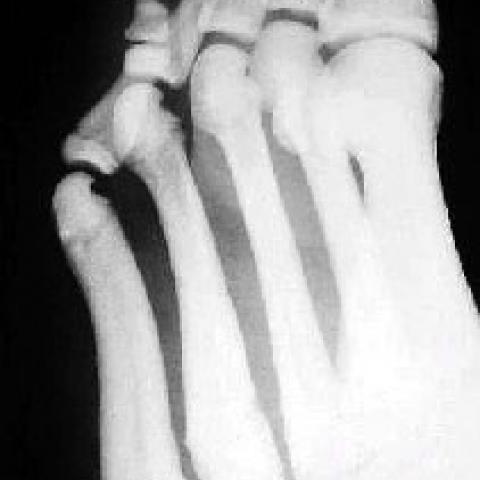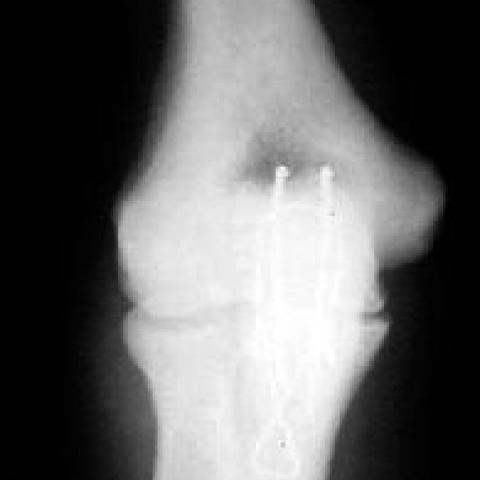


Multiple transverse fractures.
The patient presented with multiple fractures of the appendicular skeleton which needed open reduction and internal fixation.
Osteopetrosis is a rare hereditary bone disorder that presents in one of three forms: osteopetrosis tarda, osteopetrosis congenita and marble bone disease.
Osteopetrosis tarda, the benign form, is autosomal dominant and presents in adulthood with an increased susceptibilty to fracture. Healing is normal, and 50% of patients are asymptomatic.
Osteopetrosis congenita is autosomal recessive and presents in infancy. The prognosis is poor. There is severe bone marrow failure and growth retardation. This is complicated by blindness, hydrocephalus and deafness.
Marble bone disease is also autosomal recessive, and presents in childhood with renal tubular acidosis, intracranial calcification, sensorineural hearing loss and psychomotor retardation. There are no features of bone marrow failure. The prognosis is poor.
The radiological features of osteopetrosis include diffuse osteosclerosis, cortical thickening and medullary encroachment. 'Bone within bone' appearance, sandwich vertebrae and Erlenmeyer flask deformity are also described.
Common complications include transverse fractures with abundant callus formation, and bone marrow failure. Acute leukemia is a recognised complication.
Osteopetrosis tarda requires no treatment per se except for the fractures. Several treatments have been described for the malignant form including marrow transplant, which is the only cure for osteopetrosis congenita.
Osteopetrosis





Based on the provided X-ray images, the following features are observed:
Taking into account the patient’s age, clinical presentation (multiple transverse fractures), and radiographic findings, the following diagnoses or differential diagnoses may be considered:
Considering the patient is an 18-year-old male with multiple transverse fractures, imaging suggestive of diffuse osteosclerosis, narrowing of the medullary cavity, and the “bone within bone” sign as core features, along with the possibility of a hereditary background, the most likely diagnosis is:
Osteopetrosis tarda (benign form of marble bone disease)
This form typically presents in adulthood with increased fracture risk, generally favorable prognosis, and about half of the patients may be asymptomatic. The fact that this patient’s main complaint is fracture aligns with the characteristics of this benign type.
In rehabilitation training, individualized plans and safety are paramount. Given the fragile bones and risk of fracture, a low-to-high, gradual exercise approach is recommended, focusing on maintaining muscle strength and joint mobility while minimizing fall risk.
Throughout the rehabilitation process, monitor for joint pain, swelling, and neurovascular symptoms. In the event of any discomfort or new symptoms, promptly seek medical evaluation.
Disclaimer: This report is a reference analysis based on current clinical and imaging data and does not substitute for an in-person consultation or professional medical advice. Should you have further questions or experience any changes in your condition, please seek medical attention and undergo appropriate examinations in a timely manner.
Osteopetrosis